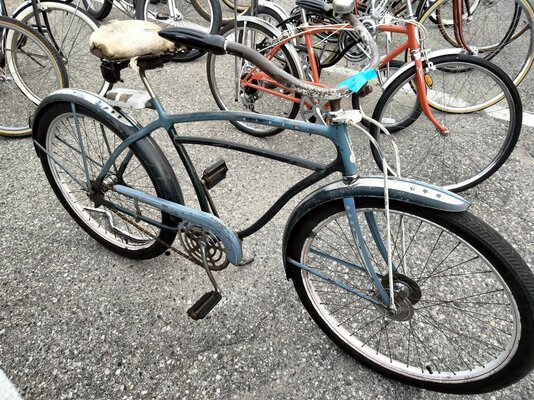Thanks. I've read the corresponding article that was originally published in the Smithsonian. I guess my misunderstanding was the bikes with the stars on the forks, I believe on PG 62 of the Hurd book were deemed Victory bikes?
So much knowledge and insight to be found here.
EDIT: After going back and re-reading the page 62 description of the Deluxe models, nowhere does it mention the word "Liberty". I'm not sure how that word ever made it's way into my head. I think it may have been the guy selling at Royal Oak swap? Who knows?
Hello...
Forget the "books."
What you actually have is an Elgin war-restricted model. PERIOD. Not a Victory model... and this is not debatable. This history ought to be clear after all these years. But unfortunately it is anything but clear. The hobby and even the industry have hopelessly confused "war-restricted" with "Victory model". At least one brand of bicycles actually referred to its entire line of 1942 bicycles as "Victory" bicycles.
Here is what actually happened... and this is not an opinion, it is a fact.
• At the end of 1941 the federal War Board and other federal entities realized that transportation would be a critical issue during World War II. Therefore the federal government devised strict specifications by which bicycles could be made. The reason was to ensure continued manufacture, but with maximum savings on materials such as steel, brass, copper, aluminum and rubber. All of these materials would be in critical need by the military. Victory bicycles (built to the federal specification) would use the least of these materials possible.
Furthermore, with many workforce adults expected to be riding bicycles to manufacturing plants, etc. the plan was to make bicycles as light as possible and as devoid of things as horn tanks, lights, knee-action forks, rear carriers, fat tires, etc. So the Victory model specification meant lightweight diamond frames, skinny tires & wheels, basic coaster brake. In short, none of these were balloon-tire bicycles.
• The federal edict for Victory bicycles was sent to everyone in the bicycle industry and went into effect in the spring of 1942.
National Bicycle History Archive of America, of course, has the full edict and related mailings today. IN the original mailers. Much of the special edict was published in
American Bicyclist & Motorcyclist trade magazine at the time it was devised.
• Officially as of spring of 1942, only two bicycle manufacturers (Huffman and Westfield) were allowed to continue making bicycles. The bicycles made were of Victory specification. Manufacture of balloon models ceased except for those assembled out of parts that already existed as of spring of 1942 (yes, some companies stocked up parts in anticipation).
• Restrictions were very severe at the beginning of WW2 and were gradually eased during the course of the war. To buy a bicycle at all, one had to be engaged in work producing war materials or for government or military. A buyer needed to have a government-issued ration ticket that allowed purchase.
• Companies other than the two federally authorized were assigned war-related manufacturing projects and things would remain so for the extent of the war. NBHAA has original correspondence from various American bicycle companies such as Iver-Johnson, Colson, Murray-Ohio, Arnold, Schwinn & Co, Delta Electric and others indicating that they were engaged in making items for the war
• Using store mail-order catalogues as the standard of what was and was not sold is a blind alley and a very, very bad way of knowing what actually was sold. We have the in-store information used by management and even it has anomolies. Balloon tire bicycles shown in wartime mail-order catalogues like Sears, Roebuck or Montgomery Ward were mostly marketing department projections of what MIGHT be available. But what you could actually buy at the stores might be wildly different. With few exceptions, balloon models were only sold as long as parts existed. In the case of manufacturers like Arnold, Schwinn & Company (ASC), the images in their catalogues were largely stamped "No longer available" or some similar wording. ASC did get a limited authorization to assemble a limited number of Cycletrucks– primarily out of existing parts.
• There were certain balloon models made strictly for the military. These were made beginning in 1941 and some continued through the war. Some of the early balloon-tire models made for the military during 1941-1942 were made by Cleveland Welding Company (yes... NBHAA has original glossy photos).
Sears Elgin war-restricted models still had balloon tires. Some even had accessories. Our unmolested Murray-built Elgin original (see attachment below) has the electric tail light and horn. We have owned it since the beginning of the 1970s. Rather than a brass headbadge, our war-restricted Elgin has the name painted on.
Every few years, somebody walks out of the mists and invents yet another term. But originally (once upon a time long before the internet) it was clearly understood which was which.
So. In the USA from 1942 to 1945 there were actual Victory model bicycles... and war-restricted model bicycles. Two different things.
Leon Dixon
National Bicycle History Archive of America
(NBHAA.com)



















